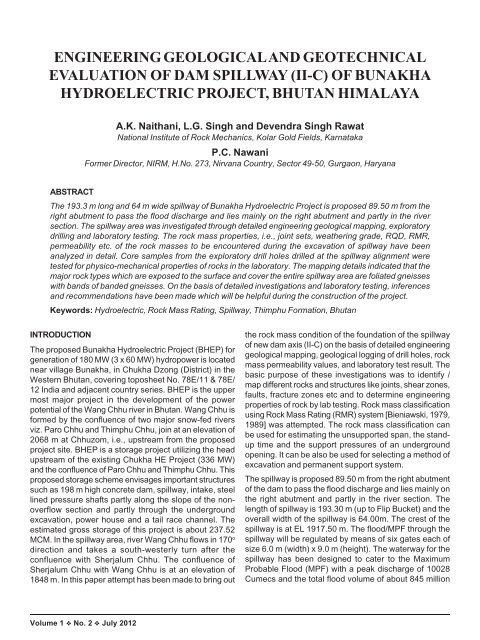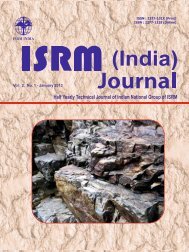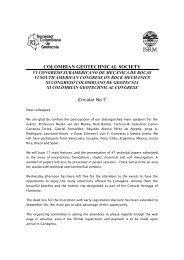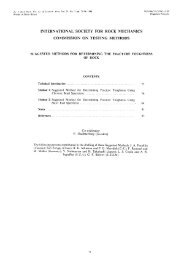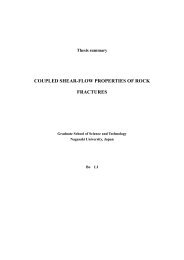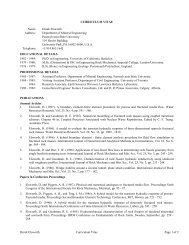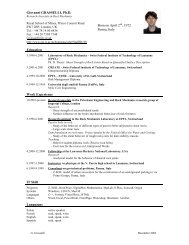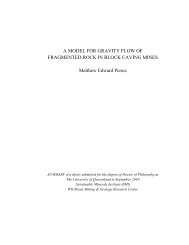ISSN : 2277-1328 (Online) - ISRM
ISSN : 2277-1328 (Online) - ISRM
ISSN : 2277-1328 (Online) - ISRM
Create successful ePaper yourself
Turn your PDF publications into a flip-book with our unique Google optimized e-Paper software.
16 <strong>ISRM</strong> (India) Journal<br />
ENGINEERING GEOLOGICAL AND GEOTECHNICAL<br />
EVALUATION OF DAM SPILLWAY (II-C) OF BUNAKHA<br />
HYDROELECTRIC PROJECT, BHUTAN HIMALAYA<br />
A.K. Naithani, L.G. Singh and Devendra Singh Rawat<br />
National Institute of Rock Mechanics, Kolar Gold Fields, Karnataka<br />
P.C. Nawani<br />
Former Director, NIRM, H.No. 273, Nirvana Country, Sector 49-50, Gurgaon, Haryana<br />
ABSTRACT<br />
The 193.3 m long and 64 m wide spillway of Bunakha Hydroelectric Project is proposed 89.50 m from the<br />
right abutment to pass the flood discharge and lies mainly on the right abutment and partly in the river<br />
section. The spillway area was investigated through detailed engineering geological mapping, exploratory<br />
drilling and laboratory testing. The rock mass properties, i.e., joint sets, weathering grade, RQD, RMR,<br />
permeability etc. of the rock masses to be encountered during the excavation of spillway have been<br />
analyzed in detail. Core samples from the exploratory drill holes drilled at the spillway alignment were<br />
tested for physico-mechanical properties of rocks in the laboratory. The mapping details indicated that the<br />
major rock types which are exposed to the surface and cover the entire spillway area are foliated gneisses<br />
with bands of banded gneisses. On the basis of detailed investigations and laboratory testing, inferences<br />
and recommendations have been made which will be helpful during the construction of the project.<br />
Keywords: Hydroelectric, Rock Mass Rating, Spillway, Thimphu Formation, Bhutan<br />
INTRODUCTION<br />
The proposed Bunakha Hydroelectric Project (BHEP) for<br />
generation of 180 MW (3 x 60 MW) hydropower is located<br />
near village Bunakha, in Chukha Dzong (District) in the<br />
Western Bhutan, covering toposheet No. 78E/11 & 78E/<br />
12 India and adjacent country series. BHEP is the upper<br />
most major project in the development of the power<br />
potential of the Wang Chhu river in Bhutan. Wang Chhu is<br />
formed by the confluence of two major snow-fed rivers<br />
viz. Paro Chhu and Thimphu Chhu, join at an elevation of<br />
2068 m at Chhuzom, i.e., upstream from the proposed<br />
project site. BHEP is a storage project utilizing the head<br />
upstream of the existing Chukha HE Project (336 MW)<br />
and the confluence of Paro Chhu and Thimphu Chhu. This<br />
proposed storage scheme envisages important structures<br />
such as 198 m high concrete dam, spillway, intake, steel<br />
lined pressure shafts partly along the slope of the nonoverflow<br />
section and partly through the underground<br />
excavation, power house and a tail race channel. The<br />
estimated gross storage of this project is about 237.52<br />
MCM. In the spillway area, river Wang Chhu flows in 170 o<br />
direction and takes a south-westerly turn after the<br />
confluence with Sherjalum Chhu. The confluence of<br />
Sherjalum Chhu with Wang Chhu is at an elevation of<br />
1848 m. In this paper attempt has been made to bring out<br />
the rock mass condition of the foundation of the spillway<br />
of new dam axis (II-C) on the basis of detailed engineering<br />
geological mapping, geological logging of drill holes, rock<br />
mass permeability values, and laboratory test result. The<br />
basic purpose of these investigations was to identify /<br />
map different rocks and structures like joints, shear zones,<br />
faults, fracture zones etc and to determine engineering<br />
properties of rock by lab testing. Rock mass classification<br />
using Rock Mass Rating (RMR) system [Bieniawski, 1979,<br />
1989] was attempted. The rock mass classification can<br />
be used for estimating the unsupported span, the standup<br />
time and the support pressures of an underground<br />
opening. It can be also be used for selecting a method of<br />
excavation and permanent support system.<br />
The spillway is proposed 89.50 m from the right abutment<br />
of the dam to pass the flood discharge and lies mainly on<br />
the right abutment and partly in the river section. The<br />
length of spillway is 193.30 m (up to Flip Bucket) and the<br />
overall width of the spillway is 64.00m. The crest of the<br />
spillway is at EL 1917.50 m. The flood/MPF through the<br />
spillway will be regulated by means of six gates each of<br />
size 6.0 m (width) x 9.0 m (height). The waterway for the<br />
spillway has been designed to cater to the Maximum<br />
Probable Flood (MPF) with a peak discharge of 10028<br />
Cumecs and the total flood volume of about 845 million<br />
Volume 1 No. 2 July 2012


